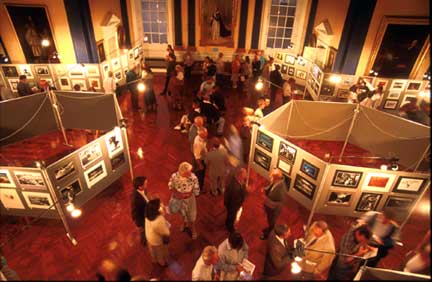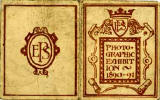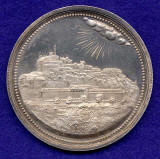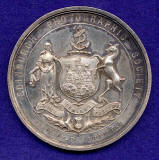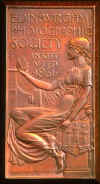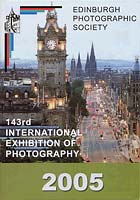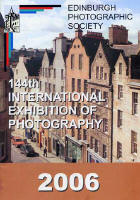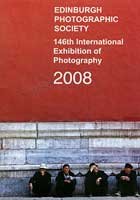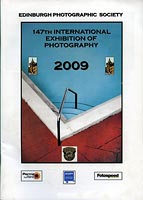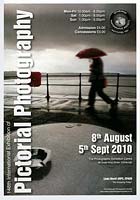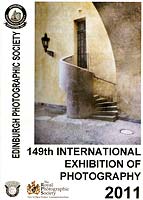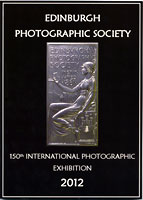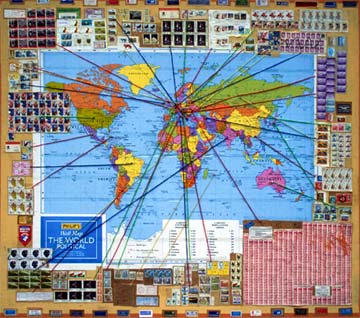|
A Brief History of
Edinburgh 1920s Catalogue © Reproduced by courtesy of Edinburgh Photographic Society This article was written for the Opening of 150th EPS Exhibition on Aug4, 2012 |
|
Please scroll down this page or click on a link below. |
|
1. Before EPS |
|
1. Before EPS |
|
· Photography was brought to the attention of the general public when it was included in the Great Exhibition in London in 1851. · Over the next decade, several photographic societies were founded including The Photographic Society (now RPS) in 1853 and the Photographic Society of Scotland (PSS) in 1856. · PSS was founded under the patronage of Prince Albert. Sir David Brewster was President. PSS held its first exhibition in December 1856 when the society was only 9 months old. There were 1,050 prints and 8,000 visitors. The exhibition included entries from:
- DO Hill (Edinburgh) · The press spoke favourably abut the exhibition: "Another Exhibition has opened to delight our pleasure-loving Auld Reekieites who are noted as dillettántí and Fine-Art rhapsodists. Photography already appears scarcely less marvellous than the electric telegraph” Caledonian Mercury: 22 Dec 1856 · There was still a novelty in viewing photos when the first PSS Exhibition was held. The Courant published a poem about this exhibition, describing the photos as paintings made by the sun, 'Old Sol'. Here is the final verse of the poem: "Old Sol had scarcely spoken thus, when forth I went straightway To his Great Exhibition-Room, my shilling there to pay. And scarcely had I passed the door, and laid my money down When I exclaimed 'A shilling's worth! Why this is worth a crown. He really is a painter! His own account is true.
I only wish we saw him here far oft'ner than we do'."
Please click on No. 1 below to read the whole of this Poem, or No. 2 to read a reply, published nine days later in The Daily Scotsman. Nos. 3, 4, 5, 6 below all are poems about EPS Exhibitions that have appeared, over the years, in EPS Bulletins. No. 3 was written in 1988 when EPS received a record number of entries for its exhibition - 3994 ! 5. Pictures from an Exhibition · PSS continued to hold Annual Exhibitions until 1866. Medal Winners at these exhibitions included:
- Thomas
Annan · Following a dispute over PSS’ refusal to accept the print ‘Two Ways of Life’ from OG Rejlander in the 1857 Exhibition, several PSS Members resigned from the society and began to meet privately. They went on to found Edinburgh Photographic Society in 1861. |
|
2. Founding of EPS |
|
· EPS was founded on 20 February 1861. (President, James D Marwick, Secretary, J Traill Taylor, who become Editor of British Journal of Photography for most of the time from 1864 until his death in 1895). · From the outset, EPS included a mix of professional and amateur photographers, or as George H Slight told EPS Members in 1867: “In a good working society, there should be a thorough admixture of different classes of the community among the members, such as professionals, working amateurs of all ranks, and others calling themselves amateurs who may have only a general hankering after photographic pursuits.’ He said this last class was not to be despised. He referred to them as ‘ornamental members, useful from their position and influence in giving a certain status to a society, and in assisting to augment the funds’. · Professional Photographers, as well as amateurs, continued to play an active part in the life of EPS throughout the 19th century, several of the most prominent ones going on to become President of EPS. All the city’s professional photographers closed their premises and declared the day an Official Holiday on the occasion of the EPS Annual Picnic! |
|
3. Early Exhibitions |
|
· EPS held its first exhibition in 1861. The society was only six weeks old. But the society attracted over 700 entries to the exhibition including work from Bedford, Bisson, Fenton, Herries, Mudd, Ramage, Roger, Horatio Ross, Silvy and Tunny. · The exhibition was described as having choice specimens of photographic skill, with stereoscopes, binocular picture &c. spread over the table in great abundance. · In 1873 or ‘74, William Henry Fox Talbot was awarded a Silver Medal for three specimens of Photoglyphic Engravings. |
|
4. Exhibition Venues |
|
EPS International Exhibition at Merchants' Hall - 1995
© Copyright: For permission to reproduce, please contact peter.stubbs@edinphoto.org.uk · In some years, there were separate Open Exhibitions and Members’ Exhibitions; in other years the two were combined with separate sections for Members. · Exhibitions have usually been shown in the premises used by the society for its meetings – except for 1876,1890, and 1948-95 when public buildings were used. See the list of venues below - from 1861: 5 St Andrew Square - 1876: RSA National Galleries - from 1877: 20 George Street - 1890: RSA National Galleries - from 1891: 38 Castle Street - from 1926: 117 George Street - from 1929: 16 Royal Terrace - from 1948: YMCA Exhibition Hall - 1956: Merchant’s Hall - from 1957: St Cuthbert’s Hall - 1980: Playhouse Theatre - 1981: Royal Overseas League - from 1982: Merchant’s Hall - from 1996: 68 Great King Street
|
|
5. Major Exhibition 1876 |
|
· This was a major exhibition. It occupied the whole Royal Scottish Academy at the foot of the Mound. Six hundred guests were invited to the opening. The society reported: "Copies of a circular had been posted to nearly every photographer in Britain, America, India and the colonies, while the continent had also, so far as practicable, been attended to." · The British Journal of Photography reported "Nearly every civilised country was more or less adequately represented in the exhibition’. The exhibition included apparatus, chemicals, books and over 3,000 photos." · Many exhibits were on display: - Professor Piazzi Smyth, Astronomer Royal, exhibited the original camera with which he photographed inside the pyramids - He also exhibited his cloud camera fitted with a plano-concave converter to remove spherical distortion, and some studies of sunlit cloud. - Messrs Ross & Pringle exhibited a complete set of their daguerreotype apparatus - Two volumes of portraits by Hill & Adamson, and several other books were displayed. |
|
6. Major Exhibition 1890 |
|
|
· The 1890 Exhibition was another major exhibition, the second to be held in the RSA National Gallery at the foot of the Mound. It was on display for 8 weeks. There were: - Musical performances, provided by the String Band of the Queen’s Own Cameron Highlanders - 1,500 photos and a number of other exhibits. - Exhibition Lectures, some illustrated by popular limelight views - Exhibits including: - Early Daguerreotypes - Calotypes by Talbot and by Hill & Adamson - Copies of ‘Sun Pictures of Scotland’, ’Pencil of Nature’ and ‘Photographic Drawings’, all by Talbot. · Practical Photographer reported: "Silver printing is still well represented, but the larger and more important works are executed in carbon and platinum. Bromide also puts in a fair claim to notice. All the less usual processes are exhibited: - aristotype - kallitype - Diazotype - vitrified enamels - etc., etc." · Many Medals were awarded in this exhibition: - GOLD for the best prints in the Exhibition - 1 SILVER + 1 BRONZE for the best two prints in each of the following classes: - for Apparatus - for Materials - for Processes - 1 SILVER + 1 BRONZE for the best two prints in each of the following classes: - Landscapes 6½ x 8½ inches and under - Landscapes over 6½ x 8½ inches - Portraits below wholeplate size in sets of 12 direct prints - Portraits 6½ x 8½ inches up to 10 x 12 inches in sets of 6 direct prints - Portraits above 10 x 12 inches in sets of 6 direct prints - Single Figure Studies, not to exceed 15 x 12 inches, direct prints - Combination Printing - Genre Pictures - Instantaneous Pictures - Architecture and Engineering - Scientific: Micro-Photography, Botany, Astronomy, Geology, Surgery, &c - Landscapes, Half-plate and under. Confined to Amateurs - Photographs, any subject. Confined to Amateur Members of EPS - Pictures which have previously not Obtained a Prize - Lantern Slides, in sets of six - Reproduction of Pictures by any Process not Mechanical - Vitreous Enamels - Photo-Mechanical Prints - Enlargements, which must be accompanied by Original Negatives |
|
7. Exhibitions Around 1900 |
|
· Exhibitions continued with many medals awarded – especially to EPS Members, in the 1890s. Medals were awarded in the 1897 Exhibition for the following classes: © David Likar, Australia . Medal awarded 1896, similar to 1897 Medals For Classes open to ALL: 1 GOLD, 2 SILVER, 3 BRONZE (in total for the two classes below) - Landscape and Seascape - Figure Studies and Portraiture For Classes open only to EPS MEMBERS 1 SILVER, 1 or 2 BRONZE for each of the classes below - Best picture, half-plate size and under, other than figure or genre composition. - Best figure or genre composition. - Best picture above half-plate size, other than figure or genre composition. - Best set of 4 or 5 pictures, being work done with camera held in hand. - Best picture, being the work of a lady member. - Best enlargement. - Best set of six lantern slides - Best set of three pictures taken at the 1896 Saturday Rambles. · Exhibition Classes and Awards varied from year to year, the subject involving some protracted discussions at EPS Council Meetings. Eventually, it was decided in 1902 to award only Bronze Medals. A new rectangular ‘Art Nouveau’ style of medal was adopted, replacing the earlier large round medals. The original casting for this medal was found recently, allowing this style of Medal to be awarded again for the EPS 150th Exhibition in 2012. |
|
8. Exhibitions Around 1950 |
||||||||||||||||||
|
1948 Exhibition · A survey of 500 prints submitted revealed the somewhat unexpected information that 23 different negative sizes were used in producing them. These ranged from 1 x ¾ ins to 24 x 30 cms. By far the greatest number of prints were made from 2 ¼ x 2 ¼ ins negatives (33%): 35mms. coming next in popularity at 20%. 1948 Exhibition · The most popular printing process was Bromide (65.8%) with Bromesko and Plastika both well represented whilst Bromoil and Bromoil Transfer together amounted to only 2%. · This exhibition was held at YMCA Exhibition Hall, 4 Queen Street, during the 3rd Edinburgh Festival, from August until 10 September 1949. It attracted 3,000 visitors. EPS reported: - The Festival Society gave the Exhibition their Official Blessing.” - Entries were received from 26 countries - 210 prints were on show, selected from more than 1,000 entries. - No awards were made, but prints considered to be of outstanding merit were marked in the catalogue with an ‘A’. The catalogue included 202 prints, 50 of which were marked with an ‘A’. - Entries included Bromesko, Bromide, Chlorobromide, Bromoil, Bromoil Transfer and Plastika. 1950 Exhibition · The prints accepted in the exhibition comprised:
|
|
9. Exhibitions 1953 to 2012
|
|
Recent Exhibition Catalogues © All catalogues above to 2007:: Edinburgh Photographic Society · The EPS Exhibition has a reputation amongst photographers for being a difficult exhibition in which to gain acceptance. Most International Exhibitions accept about 25% of prints submitted. Historically, the EPS Exhibition has accepted a much smaller percentage.
· For
the 2012 Exhibition, 2,566 prints were submitted from 39 countries. · Each year since 1953, the EPS Exhibition Catalogue has given a list of: - The number of prints submitted and number accepted. - A breakdown of the above by country. · Please click on the links below to see - Number of prints submitted and number shown each year, 1953 to 2012 - Countries from which prints have been submitted each year,1953 to 2012. · Here is a chart that has been on display at the entrance to the exhibition in recent years, showing the countries from which prints have been received. Entries from Around the World
|
|
Edinburgh Photographic Society History |
||
|
For news of EPS today, please click here to view the EPS web site |
||

